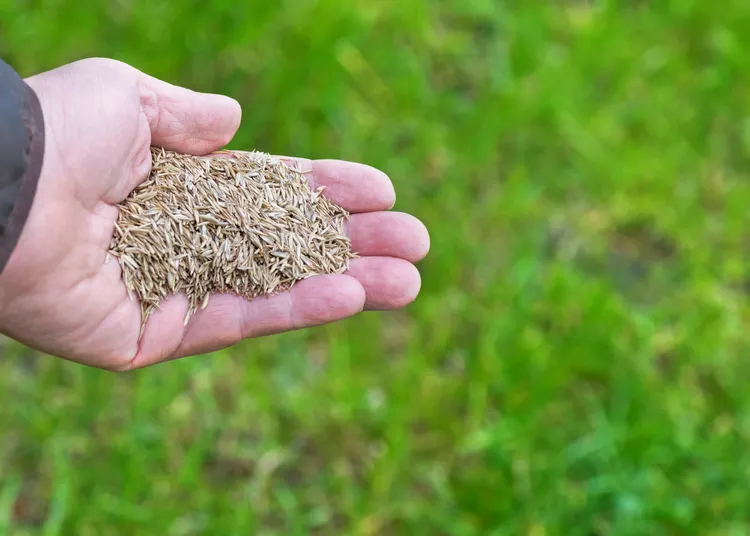If you live in a warm region, you don’t have to settle for a brown lawn this winter. All turf grasses go dormant in winter. Dormancy is natural, and there is nothing wrong with a lawn that turns brown for this reason. In warm regions (the South and Southwest), you can plant a temporary carpet of annual ryegrass seed to create a lush green lawn above dormant warm-season turf grass. The annual ryegrass will die in spring when the turf grass begins growing again.
Planting ryegrass seed over an existing lawn is called overseeding, and it takes some know-how to get good results. These 12 expert tips will ensure you enjoy a green lawn of annual ryegrass this winter.
1. Overseed bermudagrass.
There are several species of warm-season turf grasses but not all are good candidates for overseeding. Researchers have found that bermudagrass tolerates overseeding best and with the fewest long-term side effects. Resist overseeding a lawn made up of centipedgegrass, zoysiagrass, or St. Augustinegrass. These species don't appreciate the extra irrigation and fertilization that the temporary grass will require.
2. Choose annual ryegrass seed.
Two types of ryegrass seed are used for overseeding: annual and perennial. Annual ryegrass has a slightly coarser texture than softer and more lawn-like perennial ryegrass, but the benefits of annual ryegrass outweigh the difference in texture. Annual ryegrass seed is significantly less expensive than perennial ryegrass. Also, annual ryegrass will quickly die out in spring when the permanent turf emerges from dormancy. Perennial ryegrass has the potential to compete with the permanent turf.
3. Time ryegrass seeding right.
Overseed in fall when daytime temperatures are consistently in the low to mid 70s. In areas that receive frost, overseeding should occur about 30 days before the first average fall frost. Typically, lawns are overseeded in October and November. Exceptionally warm regions can overseed in December.
4. Dethatch if needed.
If the bermudagrass lawn has a thick layer of thatch—dead plant material right above the soil level—rent a dethatcher or hire a professional to remove the thatch. Once the thatch is removed, the soil will be exposed and ready for ryegrass seeding.
5. Mow low to prepare seedbed.
When overseeding with ryegrass, the seeds must filter down through the existing grass blades and contact the soil, which is key to establishing a winter lawn. Mow the bermudagrass at about 1.5 inches and bag or rake up the clippings.
6. Be mindful of seeding rate.
For good coverage and a lush lawn when using ryegrass seed, aim for the rate of 1.5 pounds of seed per 100 square feet. For small lawns, annual ryegrass can easily be spread by hand. Large lawns call for a simple hopper-style spreader available at home improvement stores.
7. Spread ryegrass seed in two directions.
Cover the area to be seeded in two directions for a uniform stand of grass. Begin by spreading half of the ryegrass seed in one direction. Spread the other half of the seed by making passes that are perpendicular to the first direction. For example, if you spread half of the seed by walking north to south, spread the other half by walking east to west.
8. Use a broom.
Ryegrass seeds must contact the soil to grow. Seeds resting on the leaf blades of the existing turfgrass will not grow. Brush the turfgrass with a stiff broom to dislodge seeds and help them filter down to the soil level.
9. Water frequently.
Water the seeded area lightly two or three times a day until the seeds germinate—usually within seven to ten days. Continue watering daily for two to three weeks until annual ryegrass is thick and lush. Aim to supply turf with a quarter-inch of water each day. Water annual ryegrass as needed once it's established.
10. Keep ryegrass mowed.
A green and growing winter lawn means winter lawn care. Begin mowing a new stand of annual ryegrass after it reaches around 3 inches tall. Maintain it at 1 ½ to 2 inches tall. Don’t let it get too long. Excessive debris from clippings can harm the permanent turf grass.
11. Fertilize after second mowing.
Apply a nitrogen-rich lawn fertilizer after the second mowing to help annual ryegrass maintain its rich green color and good growth. Follow fertilizer package directions closely.
12. Prepare for summer.
Annual ryegrass naturally dies out in spring as the weather warms. To speed the process, mow ryegrass low—a one-inch mowing height is good. It will weaken the ryegrass and make way for the permanent grass to rejuvenate. When the permanent grass begins actively growing, apply nitrogen-rich lawn fertilizer according to package directions.
Bonus Tip: Plan on Ryegrass Seeding Yearly
Once a lawn has been overseeded with annual ryegrass, you should plan to overseed it each year or make a fall application of preemergent weed killer. Here’s the challenge: the ryegrass seed that didn't germinate the previous year will likely germinate the following year. If you choose not to overseed, ryegrass seeds will germinate in clumps, and the lawn will look weedy. The preemergent herbicide applied in fall will stop any remaining ryegrass seeds from germinating.




















